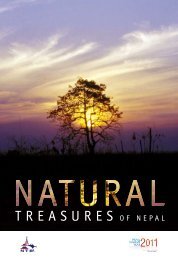treasures of nepal
treasures of nepal
treasures of nepal
- No tags were found...
You also want an ePaper? Increase the reach of your titles
YUMPU automatically turns print PDFs into web optimized ePapers that Google loves.
The present day neo-classical buildings were alsobuilt only during the second half <strong>of</strong> the 19thcentury (Rana Regime) with Nepal’s first contactwith the western countries.Nepal’s ethnic diversity, religious and culturalbeliefs, festivities, gods and goddesses in their manymanifestations, demons, myths, legends, folkloreand myriad spiritual and supernatural elements havebeen the subject <strong>of</strong> pr<strong>of</strong>ound interest to visitors. Itscultural mosaic is enriched by folk art and artisticcreations, which are reflected in its music, musicalinstruments, paintings (thangkas), masks and curioitems <strong>of</strong> cultural significance and numerous otherobjects d’art.Harmonious inter-relationship and tolerancebetween Hinduism and Buddhism and themutual respect and acceptance <strong>of</strong> each otherhave created a congenial environment for thedevelopment <strong>of</strong> art and culture. Early visitors tothe country described the valley as the abode<strong>of</strong> the gods and goddesses where there weremore temples than houses and more gods andgoddesses than people. Writings by 7th centuryChinese travellers reported well-built townsand settlements with magnificent palaces andtemples. Its narrow streets with ro<strong>of</strong>ed brickhouses in a row on both sides, paved squares,open platforms or stages, stone water spoutsand a landscape punctuated by temples, stupas,monasteries and numerous other religious andcultural monuments added to its aestheticbeauty. An inventory prepared in 1975 statedthat more than 80 per cent <strong>of</strong> all historicalmonuments in the country were to be found inthe Kathmandu Valley. In the valley alone, therewere more than a thousand splendid monuments.This was what Brown Morton III, Chairman <strong>of</strong>the United States National Committee for theInternational Council <strong>of</strong> Monuments and Sites,had to say in 1979: “The Kathmandu Valley isperhaps the most beautiful place in the world.Hidden deep in the folds <strong>of</strong> the Himalayanmountains between India and Tibet, this exoticcentre <strong>of</strong> an exotic country is nearly a perfectsynthesis <strong>of</strong> natural and man-made beauty.”The natural splendour <strong>of</strong> the valley, its historyand cultural opulence have attracted visitors,pilgrims, traders and scholars who dared toventure into the mountains and inhospitableterrain in search <strong>of</strong> the elusive Shangri-la.What makes Kathmandu Valley unique is theamalgamation <strong>of</strong> its magnificent naturalenvironment with a living civilisation reflectedin its towns, monuments, festivities, highlystylised pageants, ritualistic customs, religioustraditions and vibrant culture.Thangka (Pauva) ArtThe art <strong>of</strong> painting in Nepal is as old as thecarvings on stone and metal, and it is variouslyexpressed in the murals, manuscripts, Gathas(wooden covers <strong>of</strong> manuscripts), and on clothand paper. As in other forms <strong>of</strong> Nepalese art,religion has played a dominant role in painting,too. Thangkas, also known as Pauvas, aretraditional paintings depicting religious themesand deities. It is prepared on a piece <strong>of</strong> finecotton or silk cloth which is coated with amixture <strong>of</strong> glue, chalk and indigo and finallyvarnished with the white <strong>of</strong> a duck’s egg mixedwith water. The Pauva paintings have generallybeen painted by traditional ethnic castes likethe Chitrakars, Shakyas, Vajracharyas and TibetanLamas.46




